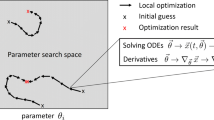Abstract
Semi-mechanistic kinetic (i.e., dynamic) models based on first principles are particularly relevant in biology, as they can explain and predict functional behavior that arises from varying concentrations of the cellular components over time. Here, we describe a computational tuning framework to facilitate both the selection of kinetic parameters for these models and its estimation from experimental data. On the one hand, the tuning framework uses multi-objective optimization to generate a model-based set of guidelines for the selection of the kinetic parameters. These parameter values are the required ones to provide a biological system with desired behavior, while fulfilling the design criteria encoded in the optimization problem itself. On the other hand, this framework can also be used to estimate the parameter values of biological systems from experimental data, once the optimization objectives had been defined appropriately. The methodology gives accurate identification results, as it provides clear orientation on the effect of the parameter values over the system’s behavior even under different experimental scenarios. It is particularly useful for easily combining time-course-averaged data and steady-state distribution data. This protocol also addresses aspects related to the appropriate description of the kinetic models and the settings of the software tools. Therefore, it supplies for hands-on testing to evaluate the validity of the underlying technical assumptions of the biological kinetic models.
This work is partially supported by grants MINECO/AEI, EU DPI2017-82896- C2-1-R and MICINN/AEI, EU PID2020-117271RB-C21.
Access this chapter
Tax calculation will be finalised at checkout
Purchases are for personal use only
Similar content being viewed by others
Notes
- 1.
Tool available in http://www.mathworks.com/matlabcentral/fileexchange/65145.
- 2.
Tool available in http://www.mathworks.com/matlabcentral/fileexchange/62224.
- 3.
Tool available in http://www.mathworks.com/matlabcentral/fileexchange/65145.
- 4.
Toolbox available in http://www.mathworks.com/matlabcentral/fileexchange/62224.
- 5.
Git repository https://github.com/sb2cl/MOOT_Selection_and_Estimation/.
References
Alon U (2019) An introduction to systems biology: design principles of biological circuits. CRC Press, Boca Raton
Blasco X, Herrero JM, Reynoso-Meza G, Martínez Iranzo MA (2017) Interactive tool for analyzing multiobjective optimization results with level diagrams. In: Proceedings of the genetic and evolutionary computation conference companion, p 1689–1696
Boada Y, Pitarch J, Vignoni A, Reynoso-Meza G, Picó J (2016) Optimization alternatives for robust model-based design of synthetic biological circuits. IFAC-PapersOnLine 49(7):821–826
Boada Y, Reynoso-Meza G, Vignoni A, Picó J (2016) Multi-objective optimization framework to obtain model-based guidelines for tuning biological synthetic devices: an adaptive network case. BMC Syst Biol 10:27
Boada Y, Vignoni A, Reynoso-Meza G, Picó J (2016) Parameter identification in synthetic biological circuits using multi-objective optimization. IFAC-PapersOnLine 49(26):77–82
Boada Y, Vignoni A, Picó J (2017) Engineered control of genetic variability reveals interplay among quorum sensing, feedback regulation, and biochemical noise. ACS Synth Biol 6(10):1903–1912
Boada Y, Vignoni A, Picó J (2017) Multi-objective identification of synthetic circuits stochastic models using flow cytometry data. In: Proceedings 25th mediterranean conference on control and automation MED, p 1077–1082. https://doi.org/10.1109/MED.2017.7984261
Boada Y, Vignoni A, Picó J (2017) Multi-objective optimization for gene expression noise reduction in a synthetic gene circuit. IFAC-PapersOnLine 50(1):4472–4477. 20th IFAC World Congress
Boada Y, Vignoni A, Alarcon-Ruiz I, Andreu-Vilarroig C, Monfort-Llorens R, Requena A, Picó J (2019) Characterization of gene circuit parts based on multiobjective optimization by using standard calibrated measurements. ChemBioChem 20(20):2653–2665
Boada Y, Vignoni A, Picó J (2020) Multiobjective identification of a feedback synthetic gene circuit. IEEE Trans Control Syst Tech 28(1):208–223. https://doi.org/10.1109/TCST.2018.2885694
Boada Y, Vignoni A, Picó J, Carbonell P (2020) Extended metabolic biosensor design for dynamic pathway regulation of cell factories. Iscience 23(7):101305
Chellaboina V, Bhat S, Haddad M, Bernstein D (2009) Modeling and analysis of mass-action kinetics. IEEE Control Syst 29(4):60–78
Elowitz MB, Levine AJ, Siggia ED, Swain PS (2002) Stochastic gene expression in a single cell. Science 297(5584):1183–1186
Gorochowski TE, di Bernardo M, Grierson CS (2010) Evolving enhanced topologies for the synchronization of dynamical complex networks. Phys Rev E 81(5):056212
Higham DJ (2001) An algorithmic introduction to numerical simulation of stochastic differential equations. SIAM Rev 43(3):525–546
Higham DJ (2008) Modeling and simulating chemical reactions. SIAM Rev 50(2):347–368
Kelley NJ, Whelan DJ, Kerr E, Apel A, Beliveau R, Scanlon R (2014) Engineering biology to address global problems: synthetic biology markets, needs, and applications. Ind Biotechnol 10(3):140–149
Kumar P, Sinha R, Shukla P (2020) Artificial intelligence and synthetic biology approaches for human gut microbiome. Crit Rev Food Sci Nutr. https://doi.org/10.1080/10408398.2020.1850415
Mallik S, Bhadra T, Seth S, Bandyopadhyay S, Chen J (2018) Multi-objective optimization approaches in biological learning system on microarray data. In: Multi-objective optimization, springer, p 159–180
Miettinen K (2012) Nonlinear multiobjective optimization, vol 12. Springer, Berlin
Picó J, Vignoni A, Boada Y (2021) Stochastic differential equations for practical simulation of gene circuits. In: Menolascina F (ed) Synthetic gene circuits, methods in molecular biology, vol 2229. Humana, New York, p 41–90
Reynoso-Meza G, Sanchis J, Blasco X, Garcia-Nieto S (2014) Physical programming for preference driven evolutionary multi-objective optimization. Appl Soft Comput 24:341–362
Ruess J, Lygeros J (2015) Moment-based methods for parameter inference and experiment design for stochastic biochemical reaction networks. ACM Trans Model Comput Simul 25(2):8
Sohlberg B, Jacobsen EW (2008) Grey box modelling–branches and experiences. IFAC Proc Volumes 41(2):11415–11420
Vignoni A, Bajur A, Knust E, Sbalzarini IF (2018) Multi-objective identification from fluorescence recovery after photobleaching experiments: understanding morphogenetic regulation of epithelial polarity. IFAC-PapersOnLine 51(19):8–11
Yaman F, Adler A, Beal J (2018) AI challenges in synthetic biology engineering. In: Proceedings of the AAAI conference on artificial intelligence, vol 32
Author information
Authors and Affiliations
Corresponding author
Editor information
Editors and Affiliations
Rights and permissions
Copyright information
© 2022 Springer Science+Business Media, LLC, part of Springer Nature
About this protocol
Cite this protocol
Boada, Y., Picó, J., Vignoni, A. (2022). Multi-Objective Optimization Tuning Framework for Kinetic Parameter Selection and Estimation. In: Vanhaelen, Q. (eds) Computational Methods for Estimating the Kinetic Parameters of Biological Systems. Methods in Molecular Biology, vol 2385. Humana, New York, NY. https://doi.org/10.1007/978-1-0716-1767-0_4
Download citation
DOI: https://doi.org/10.1007/978-1-0716-1767-0_4
Published:
Publisher Name: Humana, New York, NY
Print ISBN: 978-1-0716-1766-3
Online ISBN: 978-1-0716-1767-0
eBook Packages: Springer Protocols




